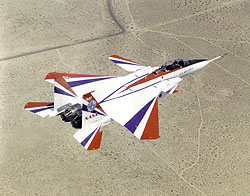
Photo courtesy of NASA, Jim Ross photographer, GRIN DataBase Number: GPN-2000-000372
Major General William "Billy" Mitchell defined air power as " the ability to do something in the air. It [consisted] of transporting all sorts of things by aircraft from one place to another." Air power may also be characterized as the ability to fly where you want, when you want, and to prevent the enemy from doing the same. Air power planning and use requires that it operate as part of a national grand strategy using strategic planning and tactical operations according to the principles of war or commerce.
Air power has grown to consist of air forces, airlines, general aviation, the aircraft and ancillary industries, as well as fuel, manpower, and other supplies. Air power also requires management through command, control, communications and intelligence. When World War I broke out in 1914, air power was in its infancy, but it grew to be an auxiliary force to be reckoned with by 1918, adding offensive capability to the primary ground-based power (the Army). Most air operations took place over the Western Front in France and consisted of reconnaissance activities--obtaining information, photographic, and making maps for the armies, and fighting to prevent others from doing the same. Very late in the war, ground-attack began to be a significant air tactic. In the meantime, grand-strategic bombing of Britain by German Zeppelin airships and Gotha bombers had targeted cities and forced British forces to divert their antiaircraft guns and fighters to defense functions. In this 1914-1918 struggle, the supply of aircraft of superior designs, of aircrew, mechanics, and fuel, was critical, as was salvage and repair.
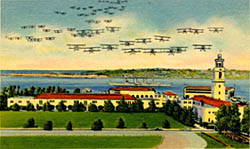
Courtesy of Jody Cook
In the inter-war years (1918-1939 for Europe and 1918-1941 for the United States) air forces and the infrastructure upon which they depended lay almost dormant except for French, British, Italian, and American colonial policing. Both the French and the British feared the air menace and talked of deterrence. Airlines began to develop, and these, though still very small by 1939, had made great technical strides in safety, speed, reliability, and comfort. Starting in 1934, modernization began with the technical revolution in machines--all-metal construction, high-octane fuels, airfields both fixed and mobile, electronics, jet propulsion, computers, and atomic bombs (nuclear weapons). These changes led to air power becoming a significant third service in the World War II battles. Not only air forces, but also air transport and the whole infrastructure were used in the war effort.
During World War II, air power was an instrument of policy in the grand strategic bombing of Britain, Germany, and Japan. It was the powerful handmaiden of the armies in the German blitzkrieg; of the lightning campaigns in the massive Soviet air armies along with all their arms; of the Allied armies; at sea in the Pacific, where both land-based air forces and carrier task forces operated; where aircraft patrolled the sea lanes in the North Atlantic; and also in the combination of armies and air transport in airborne paratroop and glider forces. Air power also used photo-reconnaissance, and wireless interception of messages proved to be a powerful intelligence tool. By mid-war, new advanced airfields could be built in three days using steel planks, and fuel could be supplied in places by pipeline. Further, a massive air logistics effort took place over "the Hump" between India and China. Equally important was salvage, repair, and maintenance in which the supply of spare parts was critical, as was POL (petrol, oil, lubricants) and tools.
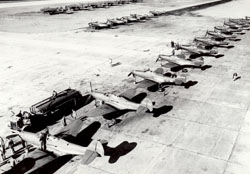
Photo from National Historic Landmarks Collection, courtesy Smithsonian Institution and U.S. Air Force
World War II saw great debates over the proper use of air power. The Germans and Soviets used it essentially as part of the ground forces in blitzkrieg; the British and the Americans started out emphasizing grand-strategic bombing, whose tactics were a form of guerrilla warfare. A third aspect was defense and here the British used air power successfully in the 1940 Battle of Britain, while defense was forced upon the Germans after 1943 and the Japanese in 1945. The Soviets on the Eastern Front used massive air armies to lead and support their tank and infantry forces. Air power was used at sea against U-boats attacking convoys in the Atlantic, and in the Pacific: both as a judo blitzkrieg carrier force, striking quick, deadly blows, and to support and protect amphibious operations. These forces ultimately seized the island bases from which the grand-strategic bombing of Japan was launched in conjunction with carrier attacks and submarine assaults on shipping.
The dropping of atomic bombs on top of the fire raids on Japan showed that at last airmen had developed the deterrent power that had failed to prevent war in 1939. After Hiroshima and Nagasaki in 1945, which ended World War II, air power developed along a number of peaceful and warlike lines, each requiring its own technology and machines linked through technology, manufacturers, and transfers of personnel. The helicopter, which was probably invented by Louis Breguet in France in 1909 (credit for early development of the helicopter also goes to Igor Sikorsky and Juan de la Cierva), saw use in World War II by the U.S. Armed Forces, but really came into its own in the Korean and Vietnam conflicts, where it was used from everything from scouting, troop transport and delivering the wounded to medical facilities. World War II also saw the first use of jet-propulsion aircraft-the first jet engines entered service with high-speed fighters late in World War II. The Germans flew the Heinkel He-178, the world's first turbojet airplane, at Rostock, Germany, just before World War II. Already by October 1, 1942, Robert M. Stanley flew the first U.S. jet plane, the Bell XP-5 Airacomet, at Muroc, California. The first jets in America were produced for the military. Lockheed, Republic and North American built the first jet fighters: the P-80, F-84, and F-86. The F-86 in particular stood up well against the Soviet built MiG-15s. During the Vietnam conflict the F-105 Thunderchief and F-4 Phantoms saw conflict (Over 20,000 combat missions were flown by the republic built Thunderchiefs in Vietnam) The jet has continued to be used by the U.S. Armed forces up to the present day.
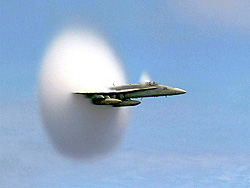
Photo courtesy Aladdinsoft.com
The airlines had benefited enormously from the mass production of airliners during World War II, and the setting up of airways and airfields (airports) around the world. The London-Los Angeles nonstop reach of the big piston-engine airliners was overtaken after 1958 by the arrival of the big jets, followed in 1969 by the Boeing 747 jumbo jet. By 1970, ocean liners had been eclipsed by airliners, and in 1976 the supersonic Concorde entered service. On domestic routes, smaller variants of British, American, French, and Soviet airlines allowed air transport outside of Europe and Japan, where there were high-speed networks, to overtake the railways.
At the same time, civil and defense manufacturing had been, like the airlines, consolidated or merged into fewer and fewer companies such as Boeing and Lockheed-Martin in the United States, and Airbus in Europe. After the break up of the Soviet Union in 1990, the Russians ceased to be players, but the Chinese had by then become important. As far as air forces have been concerned, during the Cold War of 1947-1990, the U.S. Air Force and the Royal Air Force (RAF) in NATO faced off with deterrents against the Soviet and Eastern bloc (Warsaw Pact) forces. This standoff, which included both land- and sea-based air and missile forces, also saw the development of tactical doctrines and equipment that was exercised, mainly in the West, in a number of wars, more consistently and flexibly by the Israeli Air Force in a series of clashes with the Arabs that demonstrated astute use of the principles of war.
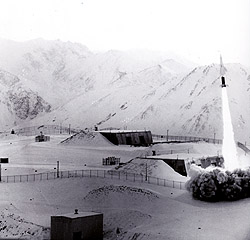
Photo from National Register collection, originally U.S. Army photo
While early on, air power theorists such as the Italian Guilio Douhet and Amadeo Mecozzi, the British F.W. Lanchester, and Sir Hugh Trenchard, and the American Billy Mitchell shared the limelight, increasingly this work has become that of staffs, especially in the Gulf War of 1991. The road to space was traveled at roughly the same pace as that seen in the introduction of the steam warship and the airplane. Rockets were being tried out in the 1930s and led in World War II to the German V-2 weapon used against Britain. After 1945, this weapon and its scientists were moved to the United States as the basis of missile programs. Other German scientists were taken to the USSR to create the weapons that created the "missile gap" crisis of 1960. Already in 1957, the Russians had orbited the Sputnik satellite which spurred the United States' efforts to create intermediate range ballistic missiles (IRBMs) and intercontinental ballistic missiles (ICBMs), and in 1969, after men had been orbited in the early 1960s, the landing on the moon. This was followed by the Mir Soviet space station, and after the end of the Cold War in 1990, by cooperation in an international space station. In the meantime, the Strategic Arms Limitation Treaty (SALT) treaties from 1970 had gradually been eliminating ballistic nuclear weapons. Since 1945, air forces' budgets have risen dramatically, but the number of machines in an air force has declined. This has been made up in the increasing lethality of weapons and in the number of people and amount of cargo that an aircraft can carry over a much longer distance, at speeds up to Mach 2.2 (1,400 miles per hour).
In contrast, airlines have merged and grown, so that a number are much larger than their neighboring air force. Airlines compete daily to make a profit from passengers and cargo. Increasingly in the latter 20th century and into the 21st, military and naval air power has been used for peacekeeping and humanitarian operations, while the airlines have demonstrated the enormous ability to make the world smaller, more peaceful, and commercial. In the years since 1903, air power has changed dramatically from a warlike infant to a pacific giant, from a mouse to an elephant.
Taken from Air Power-An Overview by Robin Higham. The original version of this essay can be found at the U.S. Centennial of Flight Commission's website.
Visit the National Park Service Travel American Aviation to learn more about Aviation related Historic Sites.
Last updated: August 22, 2017
